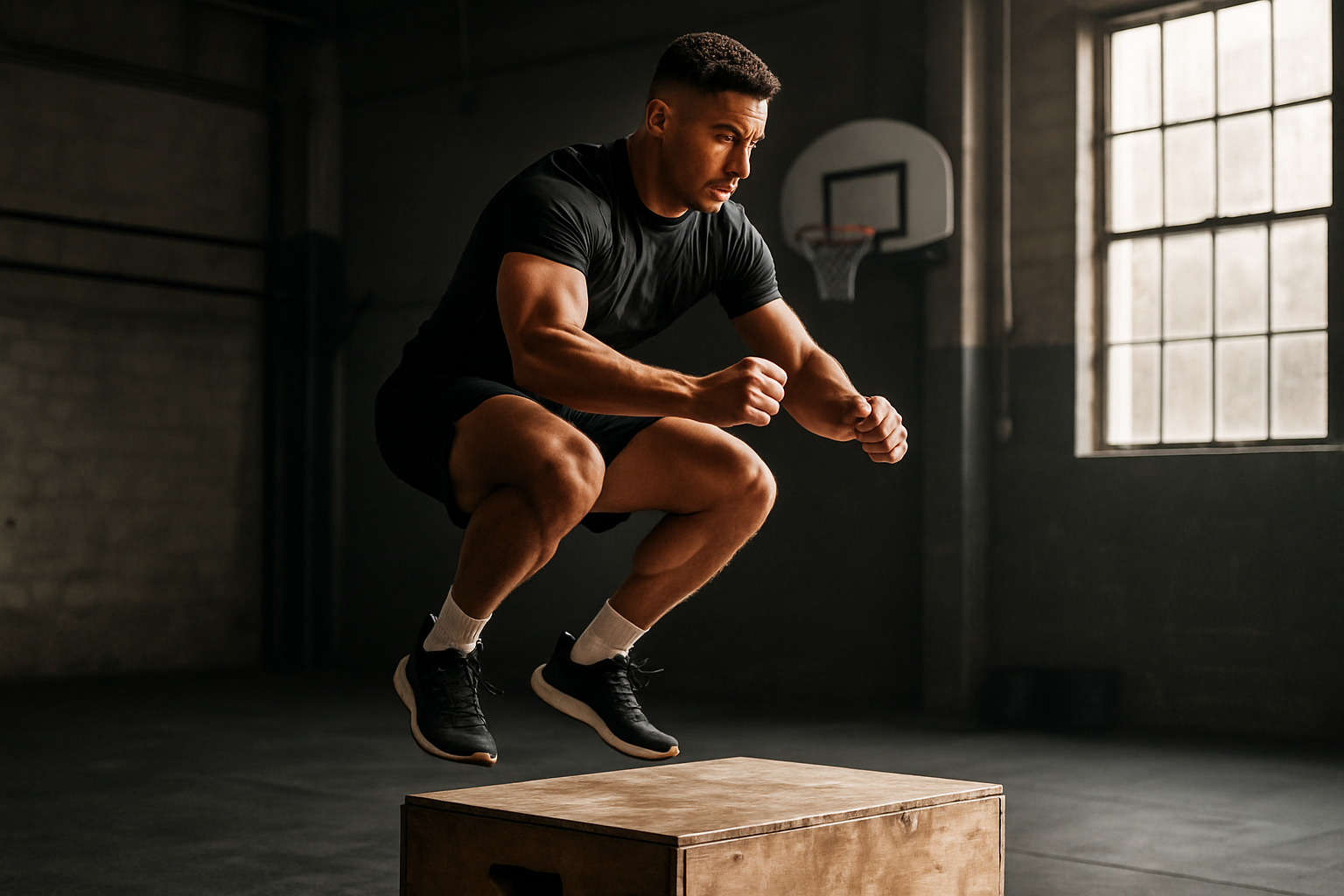Plyometric Training for Vertical Leap Enhancement
Soaring through the air, defying gravity with explosive power, athletes in various sports rely on an extraordinary vertical leap to gain a competitive edge. This article delves into the world of plyometric training, a cutting-edge method that has revolutionized how athletes approach vertical jump improvement. From basketball players reaching new heights for slam dunks to volleyball players dominating at the net, plyometric training has become an essential tool in the arsenal of sports performance enhancement.

The SSC is divided into three phases: eccentric (lengthening), amortization (transition), and concentric (shortening). Plyometric exercises aim to minimize the amortization phase, allowing for a more efficient transfer of energy and greater power output. This quick transition between stretching and contracting is what gives plyometric training its effectiveness in improving vertical leap performance.
Research has shown that plyometric training can lead to significant improvements in vertical jump height. A meta-analysis published in the Journal of Strength and Conditioning Research found that plyometric training programs lasting 10 weeks or more resulted in an average increase of 3.9 cm in vertical jump height. These gains were attributed to enhanced neural adaptations, improved muscle fiber recruitment, and increased rate of force development.
Key Plyometric Exercises for Vertical Leap
Incorporating a variety of plyometric exercises into a training regimen is crucial for maximizing vertical leap improvement. Some of the most effective exercises include:
-
Box Jumps: These involve explosively jumping onto a raised platform, focusing on quick ground contact time upon landing and immediate recoil for the next jump.
-
Depth Jumps: Starting on an elevated surface, the athlete steps off and immediately jumps vertically upon ground contact. This exercise particularly targets the rapid eccentric-to-concentric transition.
-
Tuck Jumps: Performed by jumping in place while bringing the knees to the chest, tuck jumps improve lower body power and core strength.
-
Bounding: This exercise involves exaggerated running strides, emphasizing maximum distance and hang time between each bound.
-
Split Squat Jumps: Alternating legs in a lunge position while explosively jumping, this exercise develops unilateral power and balance.
Each of these exercises targets different aspects of the vertical jump, from explosive leg drive to rapid force production and coordination. When programmed correctly, they form a comprehensive approach to vertical leap enhancement.
Periodization and Programming for Optimal Results
To maximize the benefits of plyometric training, proper periodization and programming are essential. Periodization involves systematically varying training variables over time to optimize performance and reduce the risk of overtraining. For plyometric training, this typically involves manipulating factors such as volume, intensity, and exercise selection throughout different phases of the training cycle.
A common periodization model for plyometric training includes three phases:
-
Preparatory Phase: Focus on developing a strong foundation through strength training and low-intensity plyometrics.
-
Specific Adaptation Phase: Increase the intensity and complexity of plyometric exercises, targeting sport-specific movement patterns.
-
Competition Phase: Maintain high-intensity plyometric work while reducing volume to peak for competition.
Within each phase, careful consideration must be given to exercise selection, sets, repetitions, and rest intervals. For example, a beginner might start with 2-3 sets of 5-8 repetitions of basic jumps, while an advanced athlete could progress to 4-6 sets of 8-12 repetitions of more complex movements.
Rest periods between sets are crucial for maintaining the quality and intensity of each repetition. Typically, 1-2 minutes of rest between sets is recommended, with longer rest periods for more intense exercises or when targeting maximum power output.
It’s important to note that plyometric training should be integrated into a comprehensive strength and conditioning program, not used in isolation. Combining plyometrics with traditional strength training, flexibility work, and sport-specific drills yields the best results for overall athletic performance.
Recovery and Injury Prevention in Plyometric Training
While plyometric training can be highly effective for improving vertical leap, it also places significant stress on the musculoskeletal system. Proper recovery strategies and injury prevention measures are crucial for long-term success and athlete well-being.
Recovery strategies for plyometric training include:
-
Adequate rest between sessions: Allow 48-72 hours between high-intensity plyometric workouts to ensure full recovery.
-
Proper nutrition: Emphasize protein intake for muscle repair and carbohydrates for energy replenishment.
-
Hydration: Maintain proper fluid balance to support muscle function and recovery.
-
Sleep: Prioritize quality sleep to enhance recovery and adaptation processes.
-
Active recovery: Incorporate low-intensity activities like swimming or cycling on rest days to promote blood flow and reduce muscle soreness.
Injury prevention in plyometric training focuses on proper technique, appropriate progression, and maintaining a balanced training program. Key considerations include:
-
Gradual progression: Start with low-intensity exercises and gradually increase complexity and volume over time.
-
Proper landing mechanics: Emphasize soft landings with bent knees and hips to absorb force effectively.
-
Surface selection: Use appropriate surfaces that provide some cushioning while still allowing for reactive force production.
-
Balanced strength training: Develop overall lower body and core strength to support the demands of plyometric exercises.
-
Flexibility and mobility work: Maintain adequate joint range of motion and muscle flexibility to reduce injury risk.
By implementing these recovery and injury prevention strategies, athletes can safely and effectively incorporate plyometric training into their vertical leap enhancement programs.
Real-World Applications and Success Stories
The effectiveness of plyometric training for vertical leap enhancement is evident in numerous success stories across various sports. In basketball, players like Nate Robinson and Spud Webb, both standing under 6 feet tall, became legendary for their dunking abilities, largely attributed to their intensive plyometric training regimens.
In volleyball, the Cuban national team’s dominance in the 1990s was partly due to their innovative use of plyometric training, which allowed them to out-jump much taller opponents. Their success inspired a global shift in volleyball training methods, with plyometrics becoming a cornerstone of vertical jump development in the sport.
Track and field athletes, particularly high jumpers and long jumpers, have also benefited greatly from plyometric training. For instance, Javier Sotomayor, the current world record holder in the high jump, incorporated extensive plyometric work in his training, enabling him to clear an astounding 2.45 meters (8 feet 0.46 inches).
These success stories highlight the versatility and effectiveness of plyometric training across different sports and body types. However, it’s important to note that results can vary based on individual factors such as genetics, training history, and overall athletic ability.
Technological Advancements in Plyometric Training
As sports science continues to evolve, new technologies are enhancing the effectiveness and precision of plyometric training for vertical leap improvement. Some notable advancements include:
-
Force Plates: These sophisticated devices measure ground reaction forces during jumps, providing detailed data on power output, rate of force development, and asymmetries between legs.
-
Video Analysis Software: High-speed cameras coupled with specialized software allow for frame-by-frame analysis of jumping technique, helping coaches and athletes identify areas for improvement.
-
Wearable Technology: Devices like accelerometers and gyroscopes can track metrics such as jump height, ground contact time, and power output in real-time, allowing for immediate feedback and performance monitoring.
-
Virtual Reality (VR) Training: VR systems are being developed to create immersive plyometric training environments, potentially enhancing motivation and sport-specific skill transfer.
-
Pneumatic Resistance Machines: These machines use air pressure to provide variable resistance, allowing for explosive movements with reduced joint stress compared to traditional weights.
These technological tools not only enhance the effectiveness of plyometric training but also provide valuable data for individualizing programs and tracking progress over time.
Addressing Common Misconceptions about Plyometric Training
Despite its proven effectiveness, plyometric training is sometimes surrounded by misconceptions that can lead to suboptimal implementation or avoidance altogether. Addressing these misconceptions is crucial for fostering a better understanding of plyometric training and its role in vertical leap enhancement.
Misconception 1: Plyometrics are only for elite athletes
Reality: While elite athletes certainly benefit from plyometric training, it can be safely and effectively incorporated into training programs for athletes of various levels, provided proper progression and technique are emphasized.
Misconception 2: Plyometrics always involve high-impact exercises
Reality: While some plyometric exercises are high-impact, there are many low-impact alternatives that can be used for beginners or as part of a progressive training approach.
Misconception 3: Plyometric training increases the risk of injury
Reality: When properly implemented with appropriate technique and progression, plyometric training can actually help reduce injury risk by improving joint stability and muscle reactivity.
Misconception 4: More is always better with plyometrics
Reality: Quality is more important than quantity in plyometric training. Excessive volume can lead to overtraining and increased injury risk.
Misconception 5: Plyometrics alone are sufficient for vertical leap improvement
Reality: While plyometrics are highly effective, they should be part of a comprehensive training program that includes strength training, flexibility work, and sport-specific skill development.
By dispelling these misconceptions, athletes and coaches can approach plyometric training with a more informed and balanced perspective, leading to safer and more effective implementation.
The Future of Plyometric Training and Vertical Leap Enhancement
As sports science continues to advance, the future of plyometric training for vertical leap enhancement looks promising. Emerging trends and areas of research include:
-
Individualized Training Protocols: With advancements in genetic testing and biomechanical analysis, future plyometric programs may be tailored to an individual’s unique physiological profile for optimal results.
-
Integration with Artificial Intelligence: AI algorithms could analyze vast amounts of performance data to predict optimal training loads and exercise selection for each athlete.
-
Neuromuscular Training: Greater focus on enhancing the neural aspects of plyometric performance, such as improving the speed and efficiency of motor unit recruitment.
-
Environmental Manipulation: Exploring the effects of altitude, temperature, and other environmental factors on plyometric training adaptations.
-
Long-term Athletic Development: Investigating the role of plyometric training in youth athletes and its impact on long-term vertical jump performance and overall athletic development.
-
Injury Prevention and Rehabilitation: Developing more effective protocols for using plyometrics in injury prevention and as part of rehabilitation programs.
-
Cross-disciplinary Approaches: Integrating insights from fields such as biomechanics, neuroscience, and psychology to create more holistic and effective training methodologies.
As these areas of research develop, we can expect to see even more sophisticated and effective approaches to plyometric training and vertical leap enhancement in the coming years.
Conclusion: The Leap Forward in Athletic Performance
Plyometric training has undoubtedly revolutionized the approach to vertical leap enhancement across various sports. Its foundation in sound biomechanical principles, coupled with decades of practical application and scientific research, has established it as a cornerstone of athletic performance training.
The journey from understanding the basic science of the stretch-shortening cycle to developing complex, technology-assisted training protocols highlights the evolving nature of sports science. As athletes continue to push the boundaries of human performance, plyometric training will likely remain at the forefront of vertical leap enhancement strategies.
However, it’s crucial to remember that plyometric training is not a one-size-fits-all solution. Its effectiveness depends on proper implementation, individualization, and integration within a comprehensive training program. Coaches and athletes must approach plyometric training with a balance of enthusiasm and caution, always prioritizing proper technique and progressive overload.
As we look to the future, the continued advancement of plyometric training methodologies promises to unlock even greater potential in athletic performance. From grassroots sports to elite competition, the principles of plyometric training will continue to help athletes defy gravity, reach new heights, and push the limits of vertical leap performance.
In the end, plyometric training is more than just a method for jumping higher—it’s a testament to the incredible adaptability of the human body and the relentless pursuit of athletic excellence. As sports science continues to evolve, one thing remains clear: the quest to enhance vertical leap through plyometric training will continue to inspire athletes, coaches, and researchers alike, propelling the world of sports to ever-greater heights.





